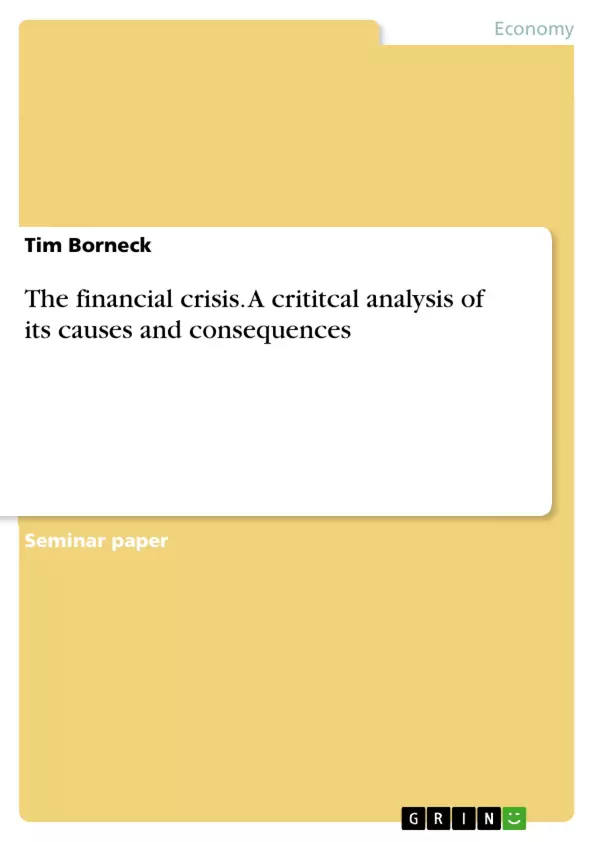In 2007 the biggest financial crisis after the ‘Great Depression’ of 1939 took place. One theoretical framework explaining financial crises of that kind was envisioned by Hyman P. Minsky (1919-1996) in the latter half of the 20th century and was not considered in this context for a long time. The most prominent part of the theoretical framework, the financial instability hypothesis (FIH), emphasises that “modern capitalist system is prone to bouts of relative instability and financial collapse. When the storm in 2007 broke it was discovered again and the world began to talk about a ‘Minsky moment’. Prominent economics called the theory a required reading and championed it as visionary. Therefore it is no surprise that the book about his FIH was traded at prices over 2000 US$ right after the financial crisis.
Until the year 2007 the economic world followed another school of thought. The so-called neoclassic described a world in which financial crises would only occur if ex-ogenous shocks would disturb the self-regulating power of the markets. In detail this is called the efficient market hypothesis (EMH). In addition means this that financial crises caused by systemically reason are not part of the theoretical model.
On the contrary, Minsky described a cyclical model which tries to implement loan rela-tionships, financial institutions, financial innovations and uncertainty in the analysis of the modern capitalism. An emphasis lays on the financing structure of different eco-nomic players and the role of financial institutions regarding their influence on the real economy. Minsky’s theory is based on the whole economic cycle and really tries to explain how financial crises are actually caused. Additionally other authors see the thoughts of Minsky as an acknowledged theory regarding financial crises in the past. Although all these factors make the theory interesting for the recent crisis and different economics had called the financial crisis a Minsky moment a huge discussion if the theory is really applicable came up. Further if the theory is really applicable the next question would be which consequences have been drawn in order to prevent another crisis.
Inhaltsverzeichnis (Table of Contents)
- Introduction
- Problem description
- Objective
- Approach
- Theoretical background of the financial instability hypothesis
- Interpretations of the General Theory by M. Keynes
- The "wall street paradigm"
- Influence of uncertainty
- Portfolio choice and preference for liquidity
- Theory of investments
- The financing structure of economic players
- The role of financial institutions
- Schumpeter's theory of economic growth
- The theory of endogenous money supply
- Financial innovations and Money-Manager Capitalism
- The financial instability hypothesis
- Expansion phase
- Contraction phase
- Implications for economic policy
- Big Government
- Big Bank and regulation of the financial markets
- Limitations of economic policy
- Analysis of the financial crisis of 2007
- The economy until the 1970s
- Evidence for Money Manager Capitalism
- Reasons for the crisis
- Political reasons and monetary factors
- Financial innovations and wrong incentives
- Ponzi finance and a downward spiral
- Consequences
Zielsetzung und Themenschwerpunkte (Objectives and Key Themes)
This work aims to provide a critical analysis of the financial crisis of 2007, examining its causes and consequences. It analyzes the theoretical framework of the financial instability hypothesis, exploring its application to the events leading up to the crisis.
- The theoretical background of the financial instability hypothesis
- The role of financial institutions and their impact on economic growth
- The consequences of the crisis for the global economy
- The potential for future financial instability
- The implications for economic policy
Zusammenfassung der Kapitel (Chapter Summaries)
- Introduction: This chapter introduces the problem of the financial crisis and its relevance, outlining the objective and approach of the work.
- Theoretical background of the financial instability hypothesis: This chapter explores the theoretical framework of the financial instability hypothesis, examining various interpretations of Keynesian economics and the role of uncertainty in financial markets.
- The financial instability hypothesis: This chapter delves into the dynamics of the financial instability hypothesis, outlining its expansion and contraction phases and their implications for economic policy.
- Analysis of the financial crisis of 2007: This chapter examines the factors that contributed to the financial crisis, including political reasons, monetary factors, financial innovations, and wrong incentives. It also explores the consequences of the crisis.
Schlüsselwörter (Keywords)
This work focuses on key themes and concepts such as financial instability, Money-Manager Capitalism, financial innovation, economic growth, monetary policy, and the consequences of the financial crisis of 2007. It utilizes theoretical frameworks like the financial instability hypothesis and Schumpeter's theory of economic growth, examining their relevance to the current economic landscape.
- Quote paper
- Tim Borneck (Author), 2015, The financial crisis. A crititcal analysis of its causes and consequences, Munich, GRIN Verlag, https://www.grin.com/document/320269



